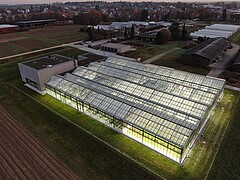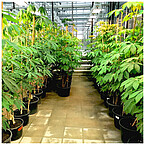Phytotechnikum:
High-tech greenhouse for climate research & bioeconomy [27.09.21]
The University of Hohenheim celebrates the handing over of what will, in future, be Germany's largest research greenhouse / The state of Baden-Württemberg & the Carl Zeiss Foundation finance approximately EUR 8.7 million in total construction costs / with video
More research on less space: This is what the new Phytotechnikum research greenhouse at the University of Hohenheim in Stuttgart has to offer. The two-bay, high-tech greenhouse with computer-controlled, precisely adjustable technology and a modular floor space layout replaces some of the individual greenhouses scattered across the campus. In two further construction phases, the greenhouse area is to be expanded to a total of around 8,200 square meters, making it probably the largest university research greenhouse in Germany. The construction of the first phase of the new building was made possible thanks to a generous grant of EUR 4 million from the Carl Zeiss Foundation to co-finance the construction costs. A further EUR 4.4 million were provided by the state of Baden-Württemberg, and EUR 300,000 by the University of Hohenheim. With science video: www.youtube.com/watch
Climate change, biodiversity, global food supply, bioenergy, renewable resources, plant health: Scientists at the University of Hohenheim are investigating these and other future-centric topics in a new high-tech research greenhouse. Researchers can now work in state-of-the-art environments in the Phytotechnikum on the west side of campus. It replaces technically outdated and, in some cases, even dilapidated greenhouses on campus, which are now being successively demolished. In the long term, the greenhouse areas on the grounds of the University of Hohenheim are to be grouped at the new location with an area of around 8,200 square meters.
Although the first construction phase of the Phytotechnikum already began in the spring of 2020, an inauguration ceremony had to be cancelled due to the Covid situation. This then took place on 27 September 2021, with a handover ceremony to which guests from political and scientific circles were invited.
At the construction ceremony, President of the University, Prof. Dr. Stephan Dabbert, expressed his enthusiasm: "The Phytotechnikum is a central building block for our most important core research areas and contributes to solving global human problems, such as food security and how agriculture can deal with the consequences of climate change."
"The Phytotechnikum is a high-tech greenhouse that facilitates basic biological research at the highest international level. We urgently need this if we are to continue to use the earth's natural resources sustainably in the future," said Dr. Felix Streiter, Executive Director of the Carl Zeiss Foundation. "As a foundation, we support socially relevant research projects in the natural sciences and engineering. That's why we were happy to support the University of Hohenheim here."
More efficiency, more competitiveness
State Secretary for Finance Dr. Gisela Splett explained the advantages of the new facility: "Previously, the greenhouses were spread around the campus. With the new building, we have combined these areas. This creates more efficiency and saves on resources."
Petra Olschowski, State Secretary in the Ministry of Science, Research and the Arts, emphasized the added value for research: "In the Phytotechnikum diverse research approaches from the fields of plant and agricultural sciences can be drawn together, resulting in an extraordinary development of this research in Germany and beyond. On this scale, the Phytotechnikum is unique in Germany and another example of the innovative technical know-how of the state of Baden-Württemberg."
Construction and expansion in three phases
The Stuttgart architectural firm Heinle, Wischer und Partner planned the first construction phase. Project management is the responsibility of the University Construction Office Stuttgart and Hohenheim. Two glass greenhouse bays have been erected on an area of around 1,400 square meters. They are connected by a building for laboratories, training, and service rooms with an area of around 400 square meters. This close proximity will also spur on research: "When researchers work together in a concentrated area, the exchange of ideas among them increases and new ideas are generated," said the President with conviction.
In two further construction phases, the entire complex will be expanded to a total of around 8,200 square meters, making it probably the largest university research greenhouse in Germany. Besides an additional 4,000 square meters of greenhouse space, the plans include an expansion of the laboratory area, extensive climate chambers, storage rooms, and a quarantine area. "We are confident that the following construction phases can also start soon," said President Prof. Dr. Dabbert. Design planning for the second construction phase began in the summer of 2021.
Less water and less energy
Above all, the utilization concept has been well thought through: heating via a dedicated district heating network ensures a low energy balance, a planned photovoltaic system on the flat roof surfaces and energy screens inside the building further reduce energy losses. As a conservative estimate, the new research greenhouse should ultimately consume around two-thirds less energy per square meter. Roughly speaking, this could translate into a four-digit number of megawatt hours saved each year.
Added to this is a sophisticated water management system: rainwater that can no longer seep away at the site of the new building is captured by the University in its own cisterns and can then be used to water plants and cool the autoclave.
1,400 square meters of glass, including state-of-the-art technology
Individual modular elements can be combined to form units of different sizes. Depending on the experimental requirements, small and large units can be quickly interconnected to form chambers of between 11 and 120 square meters, making research more flexible. "With these highly variable research units, the Phytotechnikum is building a bridge between basic scientific research and practice," said President Prof. Dr. Dabbert with satisfaction.
Inside there is state-of-the-art technology: computerized climate control and automatic watering, precise control of light intensity, humidity, and temperature, and variable lighting technology, with a choice of mercury, sodium or sulfur vapor lamps. "We can control each chamber individually and thus meet the researchers' wishes far more flexibly," explained Stefan Rühle, head of the Hohenheim Greenhouse Service Unit.
Research on a plant with potential: cassava
Researchers from the Department of Agricultural Engineering in the Tropics and Subtropics under the director Prof. Dr. Joachim Müller, for example, are very pleased about this. Among other things, they are working on the cassava plant, whose root tubers serve as a staple food in large parts of the tropics and subtropics. However, the by-products that remain after cassava harvesting, such as the leaves, stems and peel of the root tubers, could also be used potentially for food or as a feedstock for biofuels.
Among other things, the scientists are investigating how to extract protein from cassava leaves. "By growing cassava in the Phytotechnikum, we were able to study the influence of cultivar, plant age, and leaf position on plant composition. Furthermore, it also enabled us to harvest enough feedstock several times a year to develop new cassava processing techniques," said Dr. Ziba Barati, a research associate in the department. "And all of this is done without costly travel to the tropics and transporting the fresh plant material in airline luggage. Since tropical growing conditions have to be created for this, this type of cultivation is only possible for specialists like the crew from the Phytotechnikum."
Video presents the Phytotechnikum research greenhouse
A recent science video from the University of Hohenheim explains and demonstrates the function of the research greenhouse. It can now be viewed on YouTube: https://www.youtube.com/watch?v=GgaeyJIPWiU
Text: Stuhlemmer
Contact for press:
Dipl. Ing. Stefan Rühle, University of Hohenheim, Service Unit Hohenheim Greenhouses
T +49 711 459-24567, E s_ruehle@uni-hohenheim.de




